Business Team Characteristics, Models, and Performance Analysis
VerifiedAdded on 2021/02/20
|16
|4822
|478
Report
AI Summary
This report provides a comprehensive analysis of effective business teams, covering various aspects essential for their success. It begins by defining a business team and outlining key characteristics, including communication, loyalty, motivation, and cooperation. The report then delves into organization-dependent characteristics such as participative leadership, shared goals, and a common purpose. Furthermore, it explores theoretical models of team development, including Tuckman's stages of team development and Adair's Action Centred Leadership model, highlighting their application in achieving team member objectives. The report also examines the effectiveness of defined team roles, motivation techniques (Herzberg's and Maslow's theories), and performance feedback mechanisms. It concludes by discussing criteria determination for team effectiveness and strategies for developing team performance against agreed-upon criteria, emphasizing the importance of motivation and development.
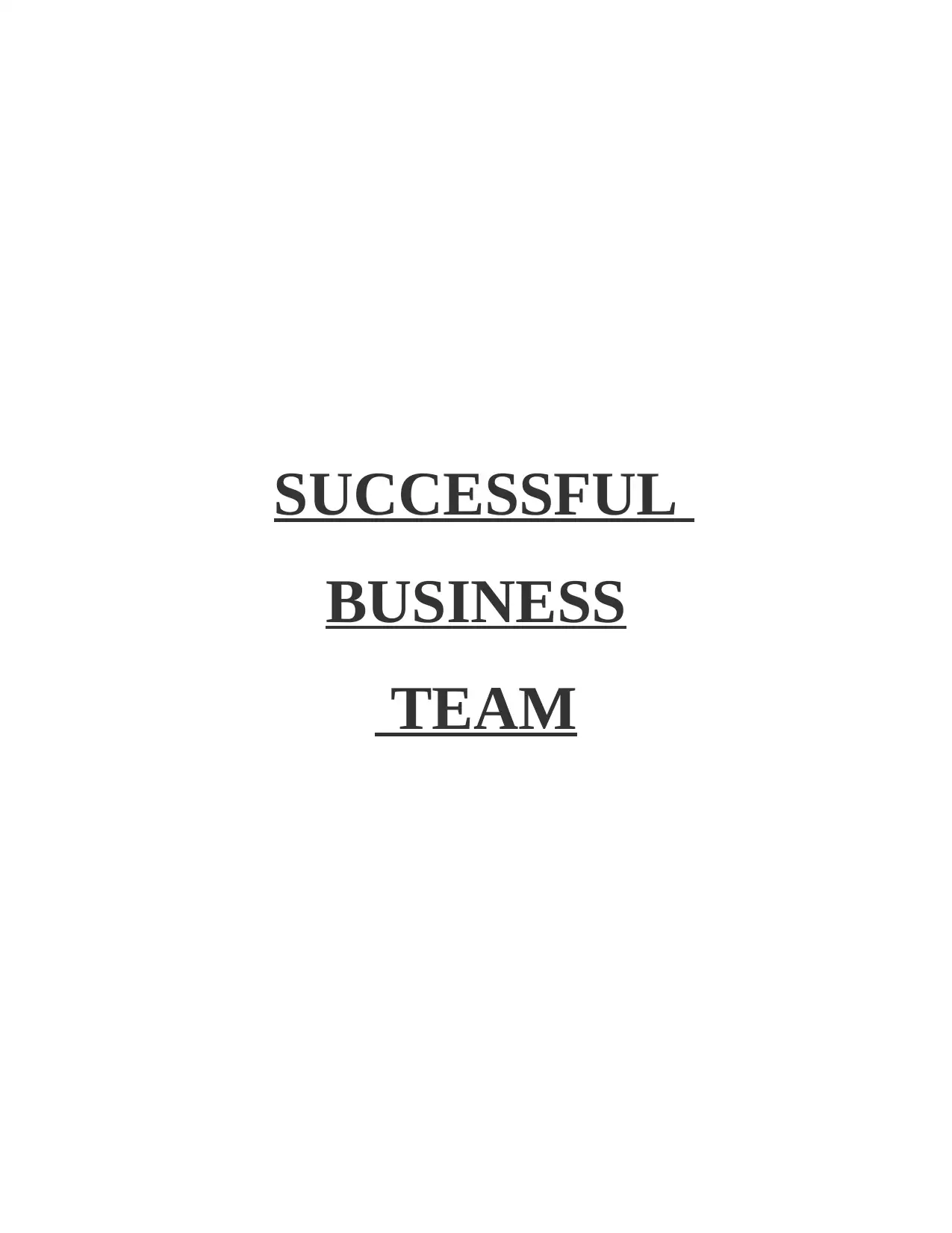
SUCCESSFUL
BUSINESS
TEAM
BUSINESS
TEAM
Paraphrase This Document
Need a fresh take? Get an instant paraphrase of this document with our AI Paraphraser
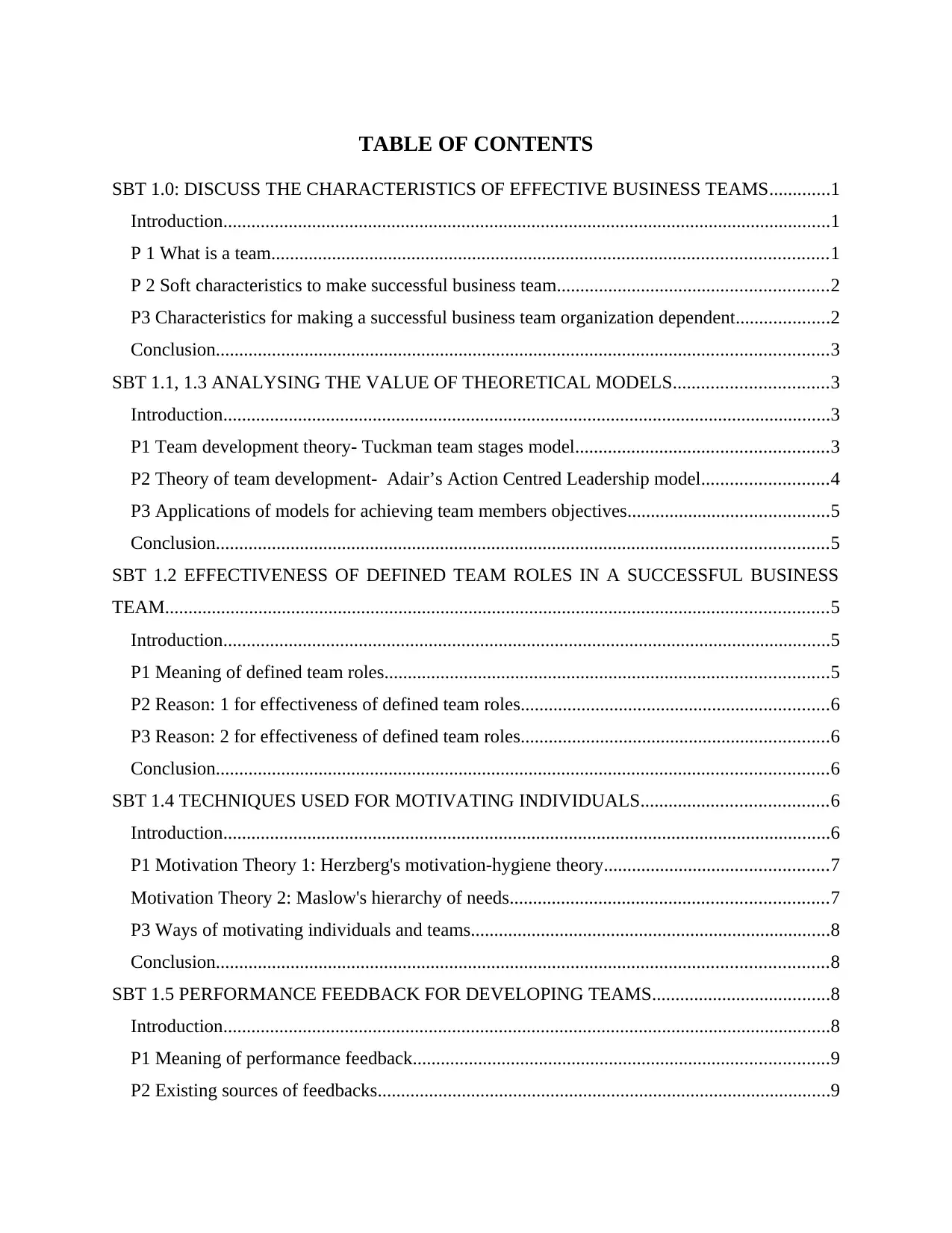
TABLE OF CONTENTS
SBT 1.0: DISCUSS THE CHARACTERISTICS OF EFFECTIVE BUSINESS TEAMS.............1
Introduction..................................................................................................................................1
P 1 What is a team.......................................................................................................................1
P 2 Soft characteristics to make successful business team..........................................................2
P3 Characteristics for making a successful business team organization dependent....................2
Conclusion...................................................................................................................................3
SBT 1.1, 1.3 ANALYSING THE VALUE OF THEORETICAL MODELS.................................3
Introduction..................................................................................................................................3
P1 Team development theory- Tuckman team stages model......................................................3
P2 Theory of team development- Adair’s Action Centred Leadership model...........................4
P3 Applications of models for achieving team members objectives...........................................5
Conclusion...................................................................................................................................5
SBT 1.2 EFFECTIVENESS OF DEFINED TEAM ROLES IN A SUCCESSFUL BUSINESS
TEAM..............................................................................................................................................5
Introduction..................................................................................................................................5
P1 Meaning of defined team roles...............................................................................................5
P2 Reason: 1 for effectiveness of defined team roles..................................................................6
P3 Reason: 2 for effectiveness of defined team roles..................................................................6
Conclusion...................................................................................................................................6
SBT 1.4 TECHNIQUES USED FOR MOTIVATING INDIVIDUALS........................................6
Introduction..................................................................................................................................6
P1 Motivation Theory 1: Herzberg's motivation-hygiene theory................................................7
Motivation Theory 2: Maslow's hierarchy of needs....................................................................7
P3 Ways of motivating individuals and teams.............................................................................8
Conclusion...................................................................................................................................8
SBT 1.5 PERFORMANCE FEEDBACK FOR DEVELOPING TEAMS......................................8
Introduction..................................................................................................................................8
P1 Meaning of performance feedback.........................................................................................9
P2 Existing sources of feedbacks.................................................................................................9
SBT 1.0: DISCUSS THE CHARACTERISTICS OF EFFECTIVE BUSINESS TEAMS.............1
Introduction..................................................................................................................................1
P 1 What is a team.......................................................................................................................1
P 2 Soft characteristics to make successful business team..........................................................2
P3 Characteristics for making a successful business team organization dependent....................2
Conclusion...................................................................................................................................3
SBT 1.1, 1.3 ANALYSING THE VALUE OF THEORETICAL MODELS.................................3
Introduction..................................................................................................................................3
P1 Team development theory- Tuckman team stages model......................................................3
P2 Theory of team development- Adair’s Action Centred Leadership model...........................4
P3 Applications of models for achieving team members objectives...........................................5
Conclusion...................................................................................................................................5
SBT 1.2 EFFECTIVENESS OF DEFINED TEAM ROLES IN A SUCCESSFUL BUSINESS
TEAM..............................................................................................................................................5
Introduction..................................................................................................................................5
P1 Meaning of defined team roles...............................................................................................5
P2 Reason: 1 for effectiveness of defined team roles..................................................................6
P3 Reason: 2 for effectiveness of defined team roles..................................................................6
Conclusion...................................................................................................................................6
SBT 1.4 TECHNIQUES USED FOR MOTIVATING INDIVIDUALS........................................6
Introduction..................................................................................................................................6
P1 Motivation Theory 1: Herzberg's motivation-hygiene theory................................................7
Motivation Theory 2: Maslow's hierarchy of needs....................................................................7
P3 Ways of motivating individuals and teams.............................................................................8
Conclusion...................................................................................................................................8
SBT 1.5 PERFORMANCE FEEDBACK FOR DEVELOPING TEAMS......................................8
Introduction..................................................................................................................................8
P1 Meaning of performance feedback.........................................................................................9
P2 Existing sources of feedbacks.................................................................................................9
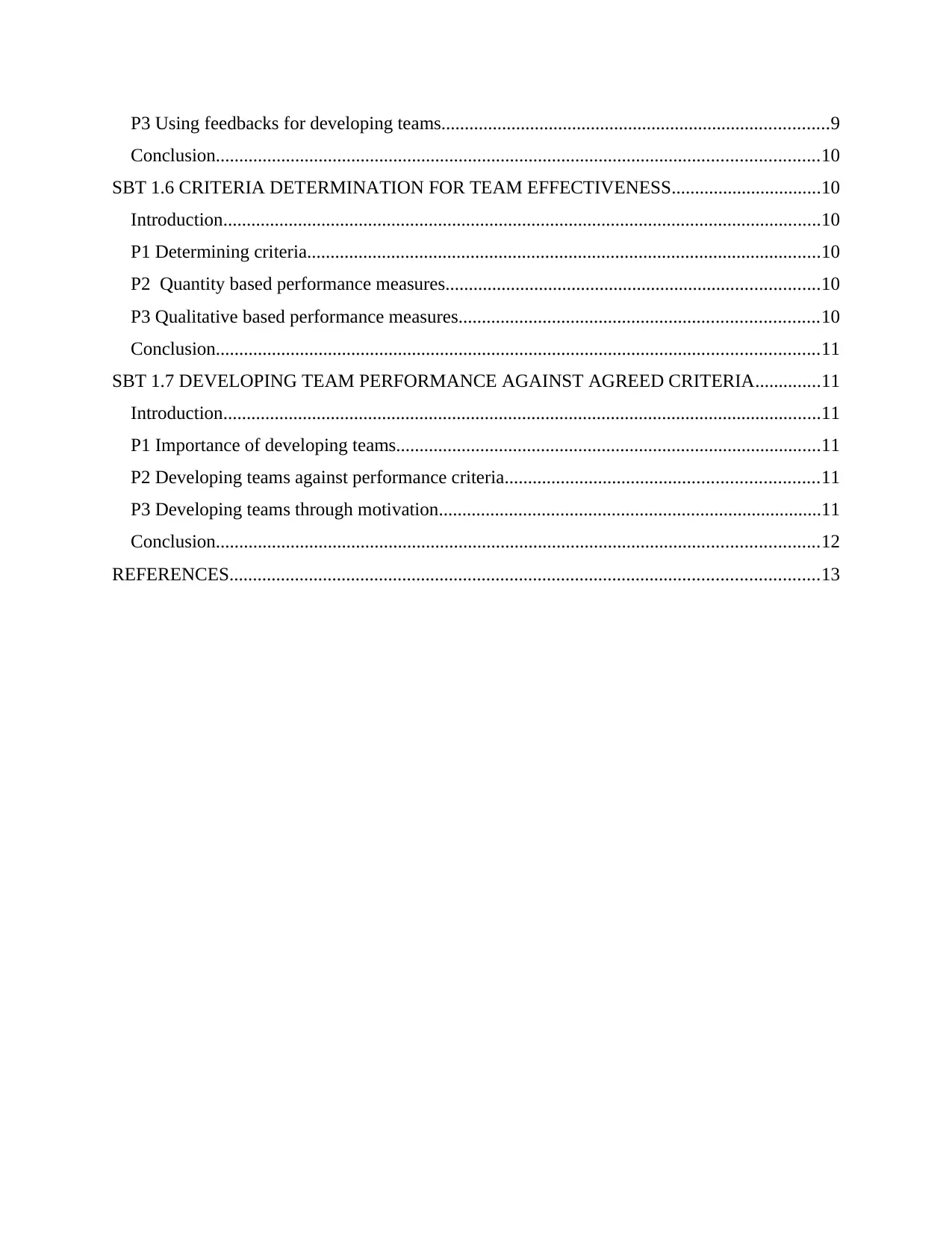
P3 Using feedbacks for developing teams...................................................................................9
Conclusion.................................................................................................................................10
SBT 1.6 CRITERIA DETERMINATION FOR TEAM EFFECTIVENESS................................10
Introduction................................................................................................................................10
P1 Determining criteria..............................................................................................................10
P2 Quantity based performance measures................................................................................10
P3 Qualitative based performance measures.............................................................................10
Conclusion.................................................................................................................................11
SBT 1.7 DEVELOPING TEAM PERFORMANCE AGAINST AGREED CRITERIA..............11
Introduction................................................................................................................................11
P1 Importance of developing teams...........................................................................................11
P2 Developing teams against performance criteria...................................................................11
P3 Developing teams through motivation..................................................................................11
Conclusion.................................................................................................................................12
REFERENCES..............................................................................................................................13
Conclusion.................................................................................................................................10
SBT 1.6 CRITERIA DETERMINATION FOR TEAM EFFECTIVENESS................................10
Introduction................................................................................................................................10
P1 Determining criteria..............................................................................................................10
P2 Quantity based performance measures................................................................................10
P3 Qualitative based performance measures.............................................................................10
Conclusion.................................................................................................................................11
SBT 1.7 DEVELOPING TEAM PERFORMANCE AGAINST AGREED CRITERIA..............11
Introduction................................................................................................................................11
P1 Importance of developing teams...........................................................................................11
P2 Developing teams against performance criteria...................................................................11
P3 Developing teams through motivation..................................................................................11
Conclusion.................................................................................................................................12
REFERENCES..............................................................................................................................13
⊘ This is a preview!⊘
Do you want full access?
Subscribe today to unlock all pages.

Trusted by 1+ million students worldwide

SBT 1.0: DISCUSS THE CHARACTERISTICS OF EFFECTIVE BUSINESS
TEAMS
Introduction
Business team is defined as group of employees working together to achieve a common
business objectives effectively and efficiently. Employees work in a team, coordinate with each
other, make decisions and share information amongst themselves to achieve business goals. This
section will answer what is meant by business team, soft characteristics of successful business
team and other characteristics which makes a team successful and organisation dependent
(André, 2017).
P 1 What is a team
Team is a defines as the willingness of people working in a group to achieve a common
goal. The main purpose of team is to increase the ability, enhance team work, participation, solve
problem, make decisions that everyone agree upon and serve customers in order to satisfy them.
Teams and groups are different from each other, groups is referred to number of individual
coordinating and working together by putting their best effort whereas on the other side team is a
group of people that share information, face many challenges and achieve a common goal. Group
cannot be a team because it does not have any goals or purpose to work for. There is various
types of team which are as follows:
Project team: They are the group of people working towards a common objective.
Specific roles, responsibilities and task are assigned to group members within which they
need to work.
Functional team: They team consist of members of same department with different roles
and responsibilities, it is a permanent team and members of team report to the manager of
department.
Matrix team: This type of team has two boss system, where team members report to
different managers for different work.
Contract team: This kind of team are tied in a contract in order to complete a specific
project. After the completion of project contract is finished (Chiocchio, Kelloway and
Hobbs, 2015).
P 2 Soft characteristics to make successful business team
There are many characteristics which make a business team successful:
1
TEAMS
Introduction
Business team is defined as group of employees working together to achieve a common
business objectives effectively and efficiently. Employees work in a team, coordinate with each
other, make decisions and share information amongst themselves to achieve business goals. This
section will answer what is meant by business team, soft characteristics of successful business
team and other characteristics which makes a team successful and organisation dependent
(André, 2017).
P 1 What is a team
Team is a defines as the willingness of people working in a group to achieve a common
goal. The main purpose of team is to increase the ability, enhance team work, participation, solve
problem, make decisions that everyone agree upon and serve customers in order to satisfy them.
Teams and groups are different from each other, groups is referred to number of individual
coordinating and working together by putting their best effort whereas on the other side team is a
group of people that share information, face many challenges and achieve a common goal. Group
cannot be a team because it does not have any goals or purpose to work for. There is various
types of team which are as follows:
Project team: They are the group of people working towards a common objective.
Specific roles, responsibilities and task are assigned to group members within which they
need to work.
Functional team: They team consist of members of same department with different roles
and responsibilities, it is a permanent team and members of team report to the manager of
department.
Matrix team: This type of team has two boss system, where team members report to
different managers for different work.
Contract team: This kind of team are tied in a contract in order to complete a specific
project. After the completion of project contract is finished (Chiocchio, Kelloway and
Hobbs, 2015).
P 2 Soft characteristics to make successful business team
There are many characteristics which make a business team successful:
1
Paraphrase This Document
Need a fresh take? Get an instant paraphrase of this document with our AI Paraphraser
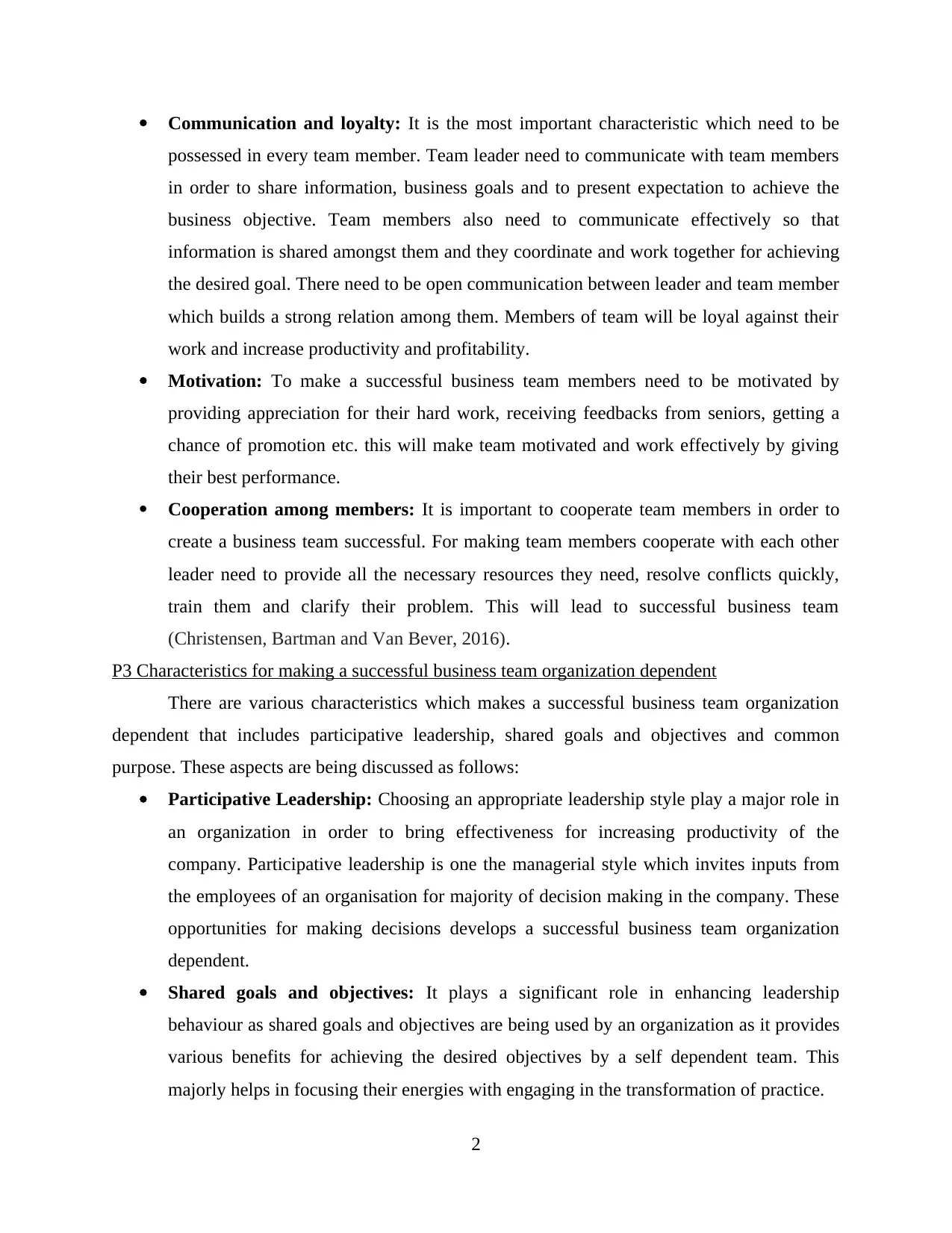
Communication and loyalty: It is the most important characteristic which need to be
possessed in every team member. Team leader need to communicate with team members
in order to share information, business goals and to present expectation to achieve the
business objective. Team members also need to communicate effectively so that
information is shared amongst them and they coordinate and work together for achieving
the desired goal. There need to be open communication between leader and team member
which builds a strong relation among them. Members of team will be loyal against their
work and increase productivity and profitability.
Motivation: To make a successful business team members need to be motivated by
providing appreciation for their hard work, receiving feedbacks from seniors, getting a
chance of promotion etc. this will make team motivated and work effectively by giving
their best performance.
Cooperation among members: It is important to cooperate team members in order to
create a business team successful. For making team members cooperate with each other
leader need to provide all the necessary resources they need, resolve conflicts quickly,
train them and clarify their problem. This will lead to successful business team
(Christensen, Bartman and Van Bever, 2016).
P3 Characteristics for making a successful business team organization dependent
There are various characteristics which makes a successful business team organization
dependent that includes participative leadership, shared goals and objectives and common
purpose. These aspects are being discussed as follows:
Participative Leadership: Choosing an appropriate leadership style play a major role in
an organization in order to bring effectiveness for increasing productivity of the
company. Participative leadership is one the managerial style which invites inputs from
the employees of an organisation for majority of decision making in the company. These
opportunities for making decisions develops a successful business team organization
dependent.
Shared goals and objectives: It plays a significant role in enhancing leadership
behaviour as shared goals and objectives are being used by an organization as it provides
various benefits for achieving the desired objectives by a self dependent team. This
majorly helps in focusing their energies with engaging in the transformation of practice.
2
possessed in every team member. Team leader need to communicate with team members
in order to share information, business goals and to present expectation to achieve the
business objective. Team members also need to communicate effectively so that
information is shared amongst them and they coordinate and work together for achieving
the desired goal. There need to be open communication between leader and team member
which builds a strong relation among them. Members of team will be loyal against their
work and increase productivity and profitability.
Motivation: To make a successful business team members need to be motivated by
providing appreciation for their hard work, receiving feedbacks from seniors, getting a
chance of promotion etc. this will make team motivated and work effectively by giving
their best performance.
Cooperation among members: It is important to cooperate team members in order to
create a business team successful. For making team members cooperate with each other
leader need to provide all the necessary resources they need, resolve conflicts quickly,
train them and clarify their problem. This will lead to successful business team
(Christensen, Bartman and Van Bever, 2016).
P3 Characteristics for making a successful business team organization dependent
There are various characteristics which makes a successful business team organization
dependent that includes participative leadership, shared goals and objectives and common
purpose. These aspects are being discussed as follows:
Participative Leadership: Choosing an appropriate leadership style play a major role in
an organization in order to bring effectiveness for increasing productivity of the
company. Participative leadership is one the managerial style which invites inputs from
the employees of an organisation for majority of decision making in the company. These
opportunities for making decisions develops a successful business team organization
dependent.
Shared goals and objectives: It plays a significant role in enhancing leadership
behaviour as shared goals and objectives are being used by an organization as it provides
various benefits for achieving the desired objectives by a self dependent team. This
majorly helps in focusing their energies with engaging in the transformation of practice.
2

Common purpose: A common purpose helps an organization in creation of an
understanding to the employees of what the organization actually stands for. This is being
performed by enabling them to make decision independently based on the information
which makes a team organization dependent (Chydenius and Jadin, 2017).
Conclusion
From this section it can be concluded that there are several characteristics which are
essential in formation of an effective business team. This section also concludes that there is a
significant difference between a group and a team which is necessary to understand by a business
of making appropriate decisions. There are various characteristics for making a successful
business team but the most essential characteristic which is required for making a team effective
is cooperation between members.
SBT 1.1, 1.3 ANALYSING THE VALUE OF THEORETICAL MODELS
Introduction
This section consist of several theories which are related to team development that can
help in understanding the effective execution of methods in developing an efficient team in an
organization. Further this includes usage of these models in order to achieve the objectives of all
the team members in an organization.
P1 Team development theory- Tuckman team stages model
Tuckman's team stages model emphasizes on the way in which a task is being tackled by
a team from the initial formation of a team to the completion of the project. The model has five
stages which includes the process where the group meets until the ending of the project. The
stages of the theory are being described as follows:
Forming Stage: It is the very first stage of team development where several aspects are
being discussed with the team members that includes skills, background and interests of
the members, goals and objectives of the project, ground rules which are to followed
while execution of the project and timeline with the individual roles in the project
(Dansoh, Oteng and Frimpong, 2017).
Storming Stage: This is the second task in development of a team where the weight of
completing the task at the hand is being hitting everyone in the team. The aspects which
3
understanding to the employees of what the organization actually stands for. This is being
performed by enabling them to make decision independently based on the information
which makes a team organization dependent (Chydenius and Jadin, 2017).
Conclusion
From this section it can be concluded that there are several characteristics which are
essential in formation of an effective business team. This section also concludes that there is a
significant difference between a group and a team which is necessary to understand by a business
of making appropriate decisions. There are various characteristics for making a successful
business team but the most essential characteristic which is required for making a team effective
is cooperation between members.
SBT 1.1, 1.3 ANALYSING THE VALUE OF THEORETICAL MODELS
Introduction
This section consist of several theories which are related to team development that can
help in understanding the effective execution of methods in developing an efficient team in an
organization. Further this includes usage of these models in order to achieve the objectives of all
the team members in an organization.
P1 Team development theory- Tuckman team stages model
Tuckman's team stages model emphasizes on the way in which a task is being tackled by
a team from the initial formation of a team to the completion of the project. The model has five
stages which includes the process where the group meets until the ending of the project. The
stages of the theory are being described as follows:
Forming Stage: It is the very first stage of team development where several aspects are
being discussed with the team members that includes skills, background and interests of
the members, goals and objectives of the project, ground rules which are to followed
while execution of the project and timeline with the individual roles in the project
(Dansoh, Oteng and Frimpong, 2017).
Storming Stage: This is the second task in development of a team where the weight of
completing the task at the hand is being hitting everyone in the team. The aspects which
3
⊘ This is a preview!⊘
Do you want full access?
Subscribe today to unlock all pages.

Trusted by 1+ million students worldwide

are being raised in this stage consist of leadership, rules, authorities, structure, evaluation,
policies, norms and reward system. These aspects are being cleared by the group
members in this stage.
Norming Stage: This stage of team development is the third stage where weighted give
and take, mutual respect, bonding and open communication is being performed between
the group members which makes this stage enjoyable for them.
Performing Stage: This is the fourth stage of team development where morale of the
members is high as they actively acknowledge the skills, talents and experience which
each members brings into the group.
Adjourning Stage: This is the closing stage of group where the objectives and goals are
being achieved and the group members move in different directions, this may also lead to
continuity of group if all the members agree for another objectives.
This model can help an organization in sustaining the performance of the teams as this model
helps in understanding how the teams evolve. This theory also helps in determining the problems
at different stages and makes sure that it doesn't effect the other stages by overcoming the
problems immediately by significantly determining them (Dunn and et.al., 2015).
P2 Theory of team development- Adair’s Action Centred Leadership model
Action centred leadership model refers to a model which provides a framework for the
leadership and management of any team, group or organization. This model is being used for
adapting and applying essential changes according to the situation in the organization. The model
is having three parts which consist of achieving the tasks, managing the team and managing
individuals. These tasks are being performed by a leader in order to effectively communicate the
missions and visions of the team and the strategies which are going to be applied for achieving
thee objectives of the team.
This model helps an organization by providing an effective framework for the purpose of
efficient leadership and management of a team in the organization. This effective organization of
team is being used by the company for performing its all the operations of a team in a significant
manner.
P3 Applications of models for achieving team members objectives
These theories are very helpful in understanding the effectiveness of business teams in an
organization. Tuckman's stages of team development is a model which seeks how a team
4
policies, norms and reward system. These aspects are being cleared by the group
members in this stage.
Norming Stage: This stage of team development is the third stage where weighted give
and take, mutual respect, bonding and open communication is being performed between
the group members which makes this stage enjoyable for them.
Performing Stage: This is the fourth stage of team development where morale of the
members is high as they actively acknowledge the skills, talents and experience which
each members brings into the group.
Adjourning Stage: This is the closing stage of group where the objectives and goals are
being achieved and the group members move in different directions, this may also lead to
continuity of group if all the members agree for another objectives.
This model can help an organization in sustaining the performance of the teams as this model
helps in understanding how the teams evolve. This theory also helps in determining the problems
at different stages and makes sure that it doesn't effect the other stages by overcoming the
problems immediately by significantly determining them (Dunn and et.al., 2015).
P2 Theory of team development- Adair’s Action Centred Leadership model
Action centred leadership model refers to a model which provides a framework for the
leadership and management of any team, group or organization. This model is being used for
adapting and applying essential changes according to the situation in the organization. The model
is having three parts which consist of achieving the tasks, managing the team and managing
individuals. These tasks are being performed by a leader in order to effectively communicate the
missions and visions of the team and the strategies which are going to be applied for achieving
thee objectives of the team.
This model helps an organization by providing an effective framework for the purpose of
efficient leadership and management of a team in the organization. This effective organization of
team is being used by the company for performing its all the operations of a team in a significant
manner.
P3 Applications of models for achieving team members objectives
These theories are very helpful in understanding the effectiveness of business teams in an
organization. Tuckman's stages of team development is a model which seeks how a team
4
Paraphrase This Document
Need a fresh take? Get an instant paraphrase of this document with our AI Paraphraser
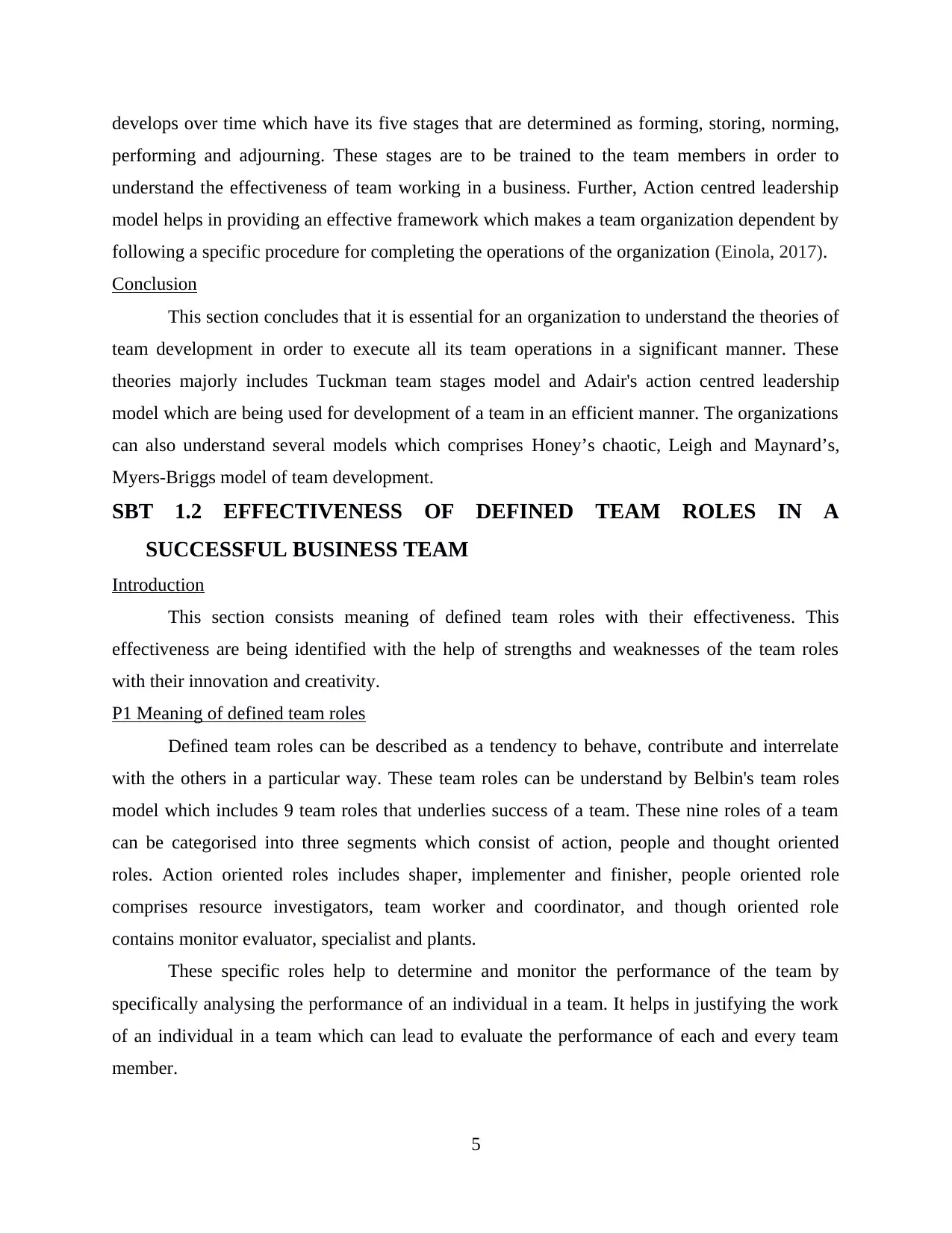
develops over time which have its five stages that are determined as forming, storing, norming,
performing and adjourning. These stages are to be trained to the team members in order to
understand the effectiveness of team working in a business. Further, Action centred leadership
model helps in providing an effective framework which makes a team organization dependent by
following a specific procedure for completing the operations of the organization (Einola, 2017).
Conclusion
This section concludes that it is essential for an organization to understand the theories of
team development in order to execute all its team operations in a significant manner. These
theories majorly includes Tuckman team stages model and Adair's action centred leadership
model which are being used for development of a team in an efficient manner. The organizations
can also understand several models which comprises Honey’s chaotic, Leigh and Maynard’s,
Myers-Briggs model of team development.
SBT 1.2 EFFECTIVENESS OF DEFINED TEAM ROLES IN A
SUCCESSFUL BUSINESS TEAM
Introduction
This section consists meaning of defined team roles with their effectiveness. This
effectiveness are being identified with the help of strengths and weaknesses of the team roles
with their innovation and creativity.
P1 Meaning of defined team roles
Defined team roles can be described as a tendency to behave, contribute and interrelate
with the others in a particular way. These team roles can be understand by Belbin's team roles
model which includes 9 team roles that underlies success of a team. These nine roles of a team
can be categorised into three segments which consist of action, people and thought oriented
roles. Action oriented roles includes shaper, implementer and finisher, people oriented role
comprises resource investigators, team worker and coordinator, and though oriented role
contains monitor evaluator, specialist and plants.
These specific roles help to determine and monitor the performance of the team by
specifically analysing the performance of an individual in a team. It helps in justifying the work
of an individual in a team which can lead to evaluate the performance of each and every team
member.
5
performing and adjourning. These stages are to be trained to the team members in order to
understand the effectiveness of team working in a business. Further, Action centred leadership
model helps in providing an effective framework which makes a team organization dependent by
following a specific procedure for completing the operations of the organization (Einola, 2017).
Conclusion
This section concludes that it is essential for an organization to understand the theories of
team development in order to execute all its team operations in a significant manner. These
theories majorly includes Tuckman team stages model and Adair's action centred leadership
model which are being used for development of a team in an efficient manner. The organizations
can also understand several models which comprises Honey’s chaotic, Leigh and Maynard’s,
Myers-Briggs model of team development.
SBT 1.2 EFFECTIVENESS OF DEFINED TEAM ROLES IN A
SUCCESSFUL BUSINESS TEAM
Introduction
This section consists meaning of defined team roles with their effectiveness. This
effectiveness are being identified with the help of strengths and weaknesses of the team roles
with their innovation and creativity.
P1 Meaning of defined team roles
Defined team roles can be described as a tendency to behave, contribute and interrelate
with the others in a particular way. These team roles can be understand by Belbin's team roles
model which includes 9 team roles that underlies success of a team. These nine roles of a team
can be categorised into three segments which consist of action, people and thought oriented
roles. Action oriented roles includes shaper, implementer and finisher, people oriented role
comprises resource investigators, team worker and coordinator, and though oriented role
contains monitor evaluator, specialist and plants.
These specific roles help to determine and monitor the performance of the team by
specifically analysing the performance of an individual in a team. It helps in justifying the work
of an individual in a team which can lead to evaluate the performance of each and every team
member.
5
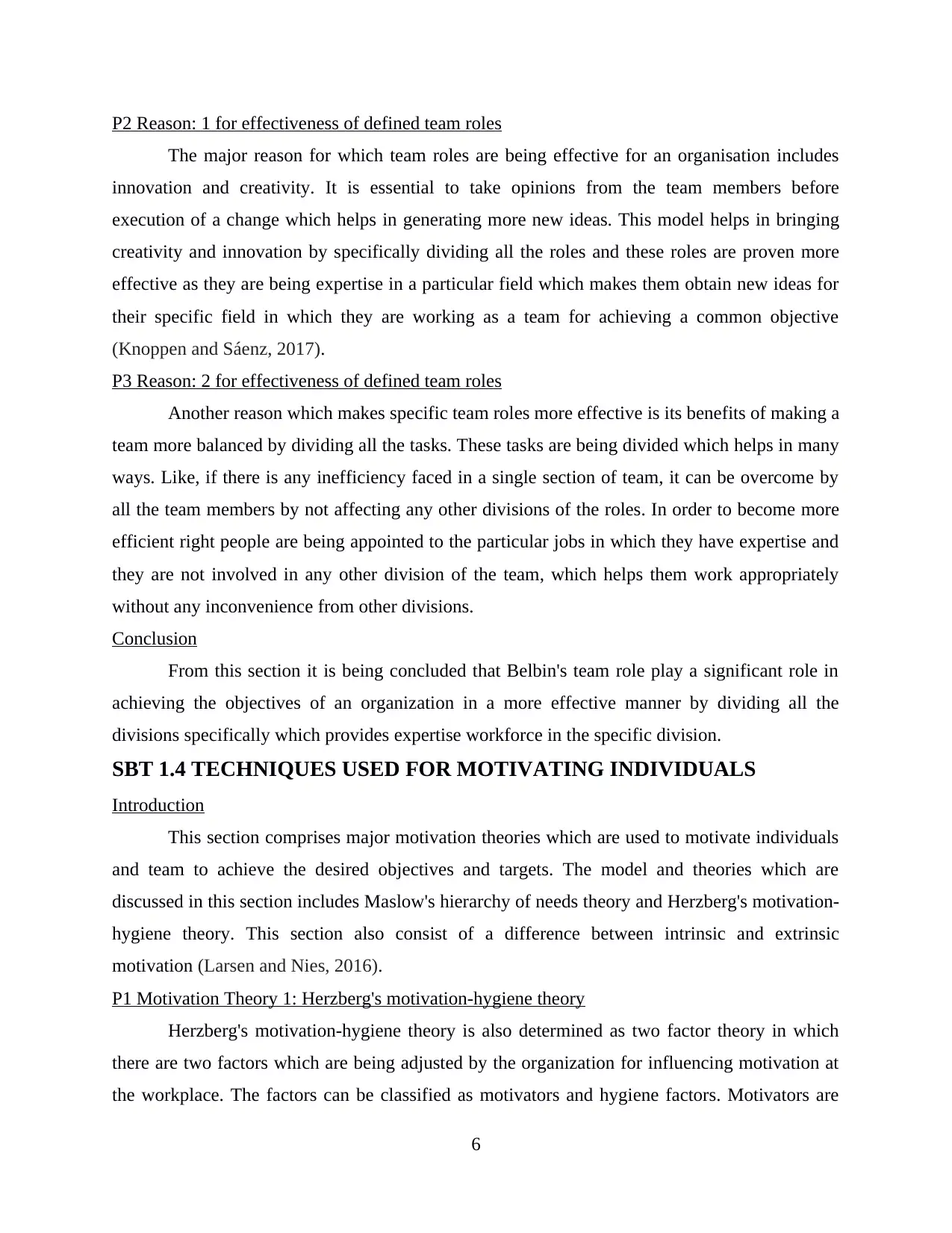
P2 Reason: 1 for effectiveness of defined team roles
The major reason for which team roles are being effective for an organisation includes
innovation and creativity. It is essential to take opinions from the team members before
execution of a change which helps in generating more new ideas. This model helps in bringing
creativity and innovation by specifically dividing all the roles and these roles are proven more
effective as they are being expertise in a particular field which makes them obtain new ideas for
their specific field in which they are working as a team for achieving a common objective
(Knoppen and Sáenz, 2017).
P3 Reason: 2 for effectiveness of defined team roles
Another reason which makes specific team roles more effective is its benefits of making a
team more balanced by dividing all the tasks. These tasks are being divided which helps in many
ways. Like, if there is any inefficiency faced in a single section of team, it can be overcome by
all the team members by not affecting any other divisions of the roles. In order to become more
efficient right people are being appointed to the particular jobs in which they have expertise and
they are not involved in any other division of the team, which helps them work appropriately
without any inconvenience from other divisions.
Conclusion
From this section it is being concluded that Belbin's team role play a significant role in
achieving the objectives of an organization in a more effective manner by dividing all the
divisions specifically which provides expertise workforce in the specific division.
SBT 1.4 TECHNIQUES USED FOR MOTIVATING INDIVIDUALS
Introduction
This section comprises major motivation theories which are used to motivate individuals
and team to achieve the desired objectives and targets. The model and theories which are
discussed in this section includes Maslow's hierarchy of needs theory and Herzberg's motivation-
hygiene theory. This section also consist of a difference between intrinsic and extrinsic
motivation (Larsen and Nies, 2016).
P1 Motivation Theory 1: Herzberg's motivation-hygiene theory
Herzberg's motivation-hygiene theory is also determined as two factor theory in which
there are two factors which are being adjusted by the organization for influencing motivation at
the workplace. The factors can be classified as motivators and hygiene factors. Motivators are
6
The major reason for which team roles are being effective for an organisation includes
innovation and creativity. It is essential to take opinions from the team members before
execution of a change which helps in generating more new ideas. This model helps in bringing
creativity and innovation by specifically dividing all the roles and these roles are proven more
effective as they are being expertise in a particular field which makes them obtain new ideas for
their specific field in which they are working as a team for achieving a common objective
(Knoppen and Sáenz, 2017).
P3 Reason: 2 for effectiveness of defined team roles
Another reason which makes specific team roles more effective is its benefits of making a
team more balanced by dividing all the tasks. These tasks are being divided which helps in many
ways. Like, if there is any inefficiency faced in a single section of team, it can be overcome by
all the team members by not affecting any other divisions of the roles. In order to become more
efficient right people are being appointed to the particular jobs in which they have expertise and
they are not involved in any other division of the team, which helps them work appropriately
without any inconvenience from other divisions.
Conclusion
From this section it is being concluded that Belbin's team role play a significant role in
achieving the objectives of an organization in a more effective manner by dividing all the
divisions specifically which provides expertise workforce in the specific division.
SBT 1.4 TECHNIQUES USED FOR MOTIVATING INDIVIDUALS
Introduction
This section comprises major motivation theories which are used to motivate individuals
and team to achieve the desired objectives and targets. The model and theories which are
discussed in this section includes Maslow's hierarchy of needs theory and Herzberg's motivation-
hygiene theory. This section also consist of a difference between intrinsic and extrinsic
motivation (Larsen and Nies, 2016).
P1 Motivation Theory 1: Herzberg's motivation-hygiene theory
Herzberg's motivation-hygiene theory is also determined as two factor theory in which
there are two factors which are being adjusted by the organization for influencing motivation at
the workplace. The factors can be classified as motivators and hygiene factors. Motivators are
6
⊘ This is a preview!⊘
Do you want full access?
Subscribe today to unlock all pages.

Trusted by 1+ million students worldwide
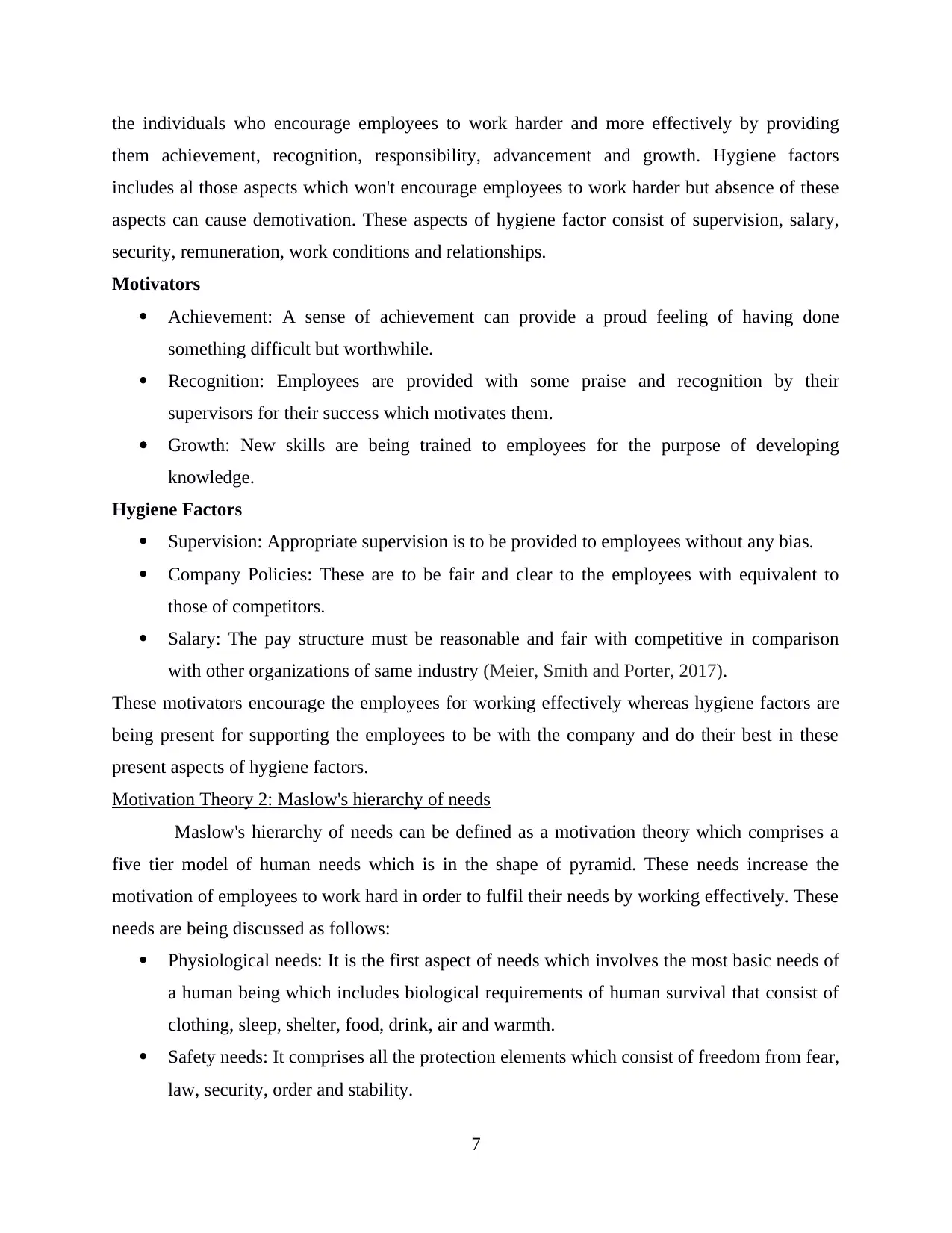
the individuals who encourage employees to work harder and more effectively by providing
them achievement, recognition, responsibility, advancement and growth. Hygiene factors
includes al those aspects which won't encourage employees to work harder but absence of these
aspects can cause demotivation. These aspects of hygiene factor consist of supervision, salary,
security, remuneration, work conditions and relationships.
Motivators
Achievement: A sense of achievement can provide a proud feeling of having done
something difficult but worthwhile.
Recognition: Employees are provided with some praise and recognition by their
supervisors for their success which motivates them.
Growth: New skills are being trained to employees for the purpose of developing
knowledge.
Hygiene Factors
Supervision: Appropriate supervision is to be provided to employees without any bias.
Company Policies: These are to be fair and clear to the employees with equivalent to
those of competitors.
Salary: The pay structure must be reasonable and fair with competitive in comparison
with other organizations of same industry (Meier, Smith and Porter, 2017).
These motivators encourage the employees for working effectively whereas hygiene factors are
being present for supporting the employees to be with the company and do their best in these
present aspects of hygiene factors.
Motivation Theory 2: Maslow's hierarchy of needs
Maslow's hierarchy of needs can be defined as a motivation theory which comprises a
five tier model of human needs which is in the shape of pyramid. These needs increase the
motivation of employees to work hard in order to fulfil their needs by working effectively. These
needs are being discussed as follows:
Physiological needs: It is the first aspect of needs which involves the most basic needs of
a human being which includes biological requirements of human survival that consist of
clothing, sleep, shelter, food, drink, air and warmth.
Safety needs: It comprises all the protection elements which consist of freedom from fear,
law, security, order and stability.
7
them achievement, recognition, responsibility, advancement and growth. Hygiene factors
includes al those aspects which won't encourage employees to work harder but absence of these
aspects can cause demotivation. These aspects of hygiene factor consist of supervision, salary,
security, remuneration, work conditions and relationships.
Motivators
Achievement: A sense of achievement can provide a proud feeling of having done
something difficult but worthwhile.
Recognition: Employees are provided with some praise and recognition by their
supervisors for their success which motivates them.
Growth: New skills are being trained to employees for the purpose of developing
knowledge.
Hygiene Factors
Supervision: Appropriate supervision is to be provided to employees without any bias.
Company Policies: These are to be fair and clear to the employees with equivalent to
those of competitors.
Salary: The pay structure must be reasonable and fair with competitive in comparison
with other organizations of same industry (Meier, Smith and Porter, 2017).
These motivators encourage the employees for working effectively whereas hygiene factors are
being present for supporting the employees to be with the company and do their best in these
present aspects of hygiene factors.
Motivation Theory 2: Maslow's hierarchy of needs
Maslow's hierarchy of needs can be defined as a motivation theory which comprises a
five tier model of human needs which is in the shape of pyramid. These needs increase the
motivation of employees to work hard in order to fulfil their needs by working effectively. These
needs are being discussed as follows:
Physiological needs: It is the first aspect of needs which involves the most basic needs of
a human being which includes biological requirements of human survival that consist of
clothing, sleep, shelter, food, drink, air and warmth.
Safety needs: It comprises all the protection elements which consist of freedom from fear,
law, security, order and stability.
7
Paraphrase This Document
Need a fresh take? Get an instant paraphrase of this document with our AI Paraphraser
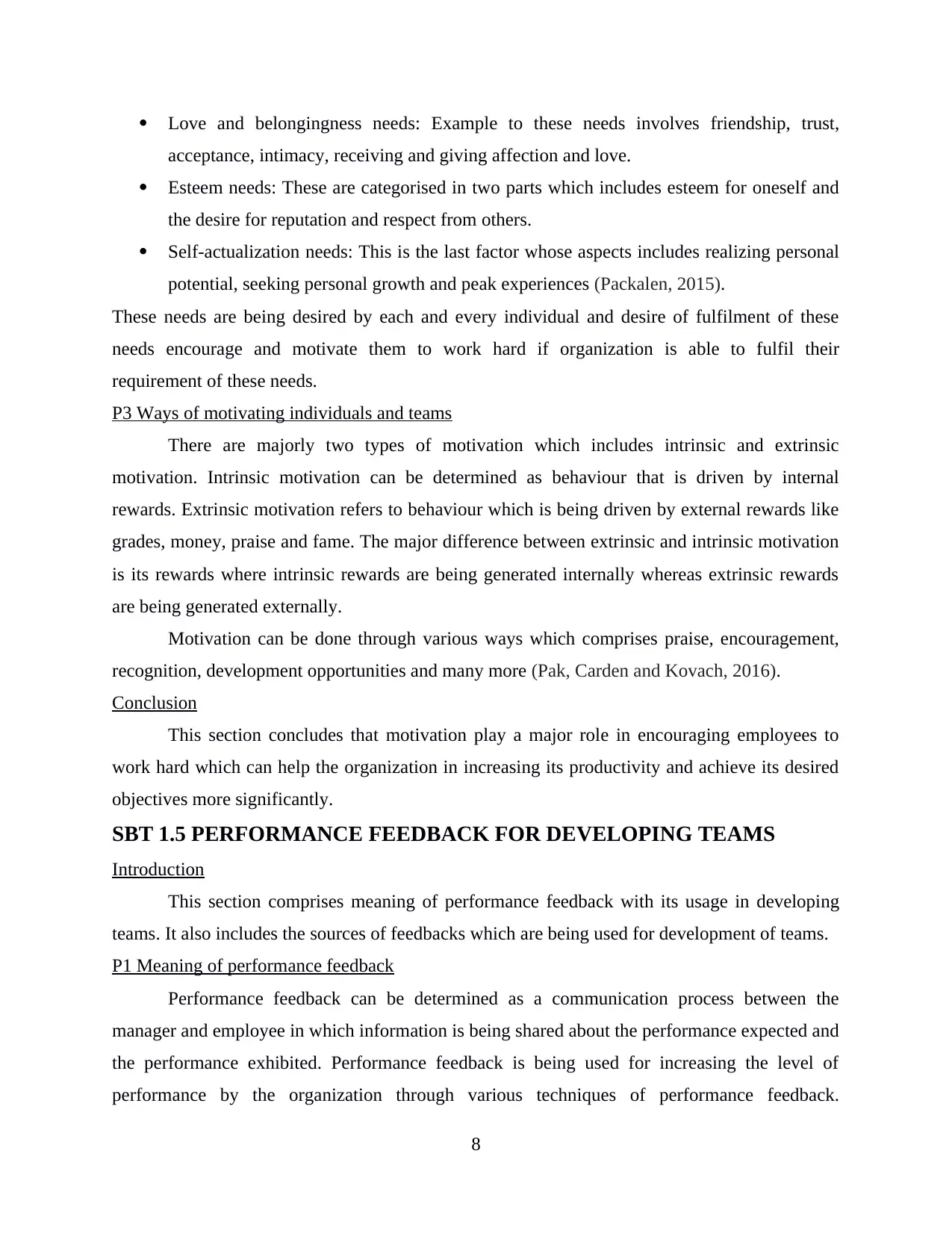
Love and belongingness needs: Example to these needs involves friendship, trust,
acceptance, intimacy, receiving and giving affection and love.
Esteem needs: These are categorised in two parts which includes esteem for oneself and
the desire for reputation and respect from others.
Self-actualization needs: This is the last factor whose aspects includes realizing personal
potential, seeking personal growth and peak experiences (Packalen, 2015).
These needs are being desired by each and every individual and desire of fulfilment of these
needs encourage and motivate them to work hard if organization is able to fulfil their
requirement of these needs.
P3 Ways of motivating individuals and teams
There are majorly two types of motivation which includes intrinsic and extrinsic
motivation. Intrinsic motivation can be determined as behaviour that is driven by internal
rewards. Extrinsic motivation refers to behaviour which is being driven by external rewards like
grades, money, praise and fame. The major difference between extrinsic and intrinsic motivation
is its rewards where intrinsic rewards are being generated internally whereas extrinsic rewards
are being generated externally.
Motivation can be done through various ways which comprises praise, encouragement,
recognition, development opportunities and many more (Pak, Carden and Kovach, 2016).
Conclusion
This section concludes that motivation play a major role in encouraging employees to
work hard which can help the organization in increasing its productivity and achieve its desired
objectives more significantly.
SBT 1.5 PERFORMANCE FEEDBACK FOR DEVELOPING TEAMS
Introduction
This section comprises meaning of performance feedback with its usage in developing
teams. It also includes the sources of feedbacks which are being used for development of teams.
P1 Meaning of performance feedback
Performance feedback can be determined as a communication process between the
manager and employee in which information is being shared about the performance expected and
the performance exhibited. Performance feedback is being used for increasing the level of
performance by the organization through various techniques of performance feedback.
8
acceptance, intimacy, receiving and giving affection and love.
Esteem needs: These are categorised in two parts which includes esteem for oneself and
the desire for reputation and respect from others.
Self-actualization needs: This is the last factor whose aspects includes realizing personal
potential, seeking personal growth and peak experiences (Packalen, 2015).
These needs are being desired by each and every individual and desire of fulfilment of these
needs encourage and motivate them to work hard if organization is able to fulfil their
requirement of these needs.
P3 Ways of motivating individuals and teams
There are majorly two types of motivation which includes intrinsic and extrinsic
motivation. Intrinsic motivation can be determined as behaviour that is driven by internal
rewards. Extrinsic motivation refers to behaviour which is being driven by external rewards like
grades, money, praise and fame. The major difference between extrinsic and intrinsic motivation
is its rewards where intrinsic rewards are being generated internally whereas extrinsic rewards
are being generated externally.
Motivation can be done through various ways which comprises praise, encouragement,
recognition, development opportunities and many more (Pak, Carden and Kovach, 2016).
Conclusion
This section concludes that motivation play a major role in encouraging employees to
work hard which can help the organization in increasing its productivity and achieve its desired
objectives more significantly.
SBT 1.5 PERFORMANCE FEEDBACK FOR DEVELOPING TEAMS
Introduction
This section comprises meaning of performance feedback with its usage in developing
teams. It also includes the sources of feedbacks which are being used for development of teams.
P1 Meaning of performance feedback
Performance feedback can be determined as a communication process between the
manager and employee in which information is being shared about the performance expected and
the performance exhibited. Performance feedback is being used for increasing the level of
performance by the organization through various techniques of performance feedback.
8

Performance feedbacks covers several aspects which includes work habits, quality of work, team
skills and service habits (Rock and Grant, 2016).
P2 Existing sources of feedbacks
There are several sources of feedbacks which can be used by an organization in order to
determine the performance of an individual and taking corrective actions to improve the same.
Sources of performance feedback are being discussed as follows:
Performance review: This includes taking review from the performance of an individual.
This can be used to determine individuals inefficiencies and overcome them by taking
corrective actions for training and development.
Monitoring activities: Monitoring systems are being installed for the purpose of
evaluating the performance of an individual and a team.
Colleagues and Customers: Direct feedbacks from customers and colleagues are helpful
in analysing the actual inefficiencies that are being faced while working in the
organization (Schoonmaker, Gettens and Vallee, 2019).
P3 Using feedbacks for developing teams
The usage of feedbacks for development of teams can be done in various aspects which
are being discussed as follows:
Listening: Leaders listen to the problems that are being faced by the individuals in a team
in order to carry out the work in an effective manner.
Observing: Leaders observe the working of the team members and make appropriate
decisions regarding significant achievement of objectives by eliminating inefficiencies.
Open communication: Team members have a conversation with the leaders and
appropriate decisions are being made regarding the feedbacks for preventing the
inefficiencies (Smith, 2017).
Conclusion
From this section, it is being concluded that performance feedback is an essential aspect
which helps in eliminating inefficiencies in the company and increases effectiveness by
overcoming the problems faced by the team members in the organization.
9
skills and service habits (Rock and Grant, 2016).
P2 Existing sources of feedbacks
There are several sources of feedbacks which can be used by an organization in order to
determine the performance of an individual and taking corrective actions to improve the same.
Sources of performance feedback are being discussed as follows:
Performance review: This includes taking review from the performance of an individual.
This can be used to determine individuals inefficiencies and overcome them by taking
corrective actions for training and development.
Monitoring activities: Monitoring systems are being installed for the purpose of
evaluating the performance of an individual and a team.
Colleagues and Customers: Direct feedbacks from customers and colleagues are helpful
in analysing the actual inefficiencies that are being faced while working in the
organization (Schoonmaker, Gettens and Vallee, 2019).
P3 Using feedbacks for developing teams
The usage of feedbacks for development of teams can be done in various aspects which
are being discussed as follows:
Listening: Leaders listen to the problems that are being faced by the individuals in a team
in order to carry out the work in an effective manner.
Observing: Leaders observe the working of the team members and make appropriate
decisions regarding significant achievement of objectives by eliminating inefficiencies.
Open communication: Team members have a conversation with the leaders and
appropriate decisions are being made regarding the feedbacks for preventing the
inefficiencies (Smith, 2017).
Conclusion
From this section, it is being concluded that performance feedback is an essential aspect
which helps in eliminating inefficiencies in the company and increases effectiveness by
overcoming the problems faced by the team members in the organization.
9
⊘ This is a preview!⊘
Do you want full access?
Subscribe today to unlock all pages.

Trusted by 1+ million students worldwide
1 out of 16
Related Documents
Your All-in-One AI-Powered Toolkit for Academic Success.
+13062052269
info@desklib.com
Available 24*7 on WhatsApp / Email
![[object Object]](/_next/static/media/star-bottom.7253800d.svg)
Unlock your academic potential
Copyright © 2020–2025 A2Z Services. All Rights Reserved. Developed and managed by ZUCOL.





